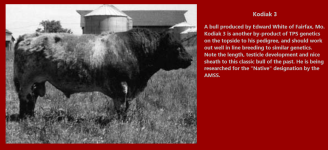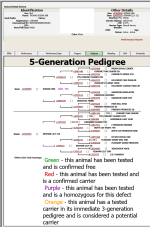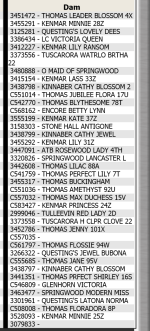oakview said:
I doubt if Galloways were infused into the Shorthorn pool for the polled gene back in the day. In the 50's and early 60's the polled cattle were almost thought of as second hand citizens by the breed's "elite." Polled cattle had their own section in Shorthorn World. Some major shows had both polled and horned divisions. Anybody that was anybody was raising "Scotch Shorthorns." I think JIT mentioned in another thread that Clipper King of Bapton, sire of TH carrier Clipper King of USA, came from a herd that had Galloways in addition to their Shorthorns. Bulls get out, you know. I've had a mystery calf or two over the past 50+ years myself. Perhaps a logical explanation of how the Clipper Kings got the "bug." We'll probably never know for sure.
Many of the " mistakes" of the past we just that... mistakes. Others were deliberate. After being in Scotland and talking with some of the older breeders, I think it is safe to say that there were a few well known breeders in that era that were not Saints. The same can be said for breeders today, however today we have DNA technology to help police the breed's gene pool.
I remember when I was on the board of the Canadian Shorthorn Association, which was prior to any thoughts of having DNA testing, we met with the Head registrar of Canadian Livestock Records Corporation, CLRC were the registrar for almost all breeds in Canada at that time, and still maintain the records for many breeds and species today.
I asked the question to the registrar, if he had any idea of how many cattle were being registered with the wrong pedigree information? He replied that in his estimation it was between 10-15% of all cattle registered at that time. He said some of these errors would be true mistakes, and some would be considered to be true deception by the breeder. At that time, the only means of determining some of these errors was by blood typing technology. Ohio State was a leader in that day of blood typing technology and I also remember asking the head of the Blood Typing lab at Ohio State the question of how accurate blood typing technology was? He said while it was the most accurate method available, there was still many flaws in this system. He said one example was that there were 8 fullblood Maine Anjou imported bulls that showed a blood type that suggested purebred Shorthorn. He said that there were some blood typing issues in almost every breed. He also said that he could not understand why the American and Canadian Shorthorn Associations had accepted the Irish strain into their herd books as purebreds, when some of them had totally different blood types than they had ever seen in the Shorthorn breed.
Several years ago, a friend of mine was asked to help one of his neighbors register the calves from his 300 head of registered Polled Herefords. He said that when he started to fill in the information of the first calf, he asked the owner what the sire of this calf was? He replied " what bulls are popular today?" My friend said he knew right then, that it was going to be a very long night as this breeder had virtually no records and made the registrations out from his head. After seeing how bad this was going to be, my friend told this owner that he could not help him get the registrations done. About 3 years later, this herd was dispersed, and it was interesting that all the calves from that calf crop were registered and were sired by some of the best sires in the breed at that time. This story may have been a rare occurrence back then, but I really don't think it was as rare as some would think.



